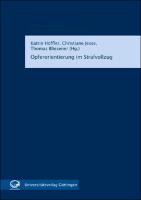Opferorientierung im Strafvollzug
Contributor(s)
Höffler, Katrin (editor)
Jesse, Christiane (editor)
Bliesener, Thomas (editor)
Collection
AG UniversitätsverlageLanguage
English; GermanAbstract
The feeling of grief and other emotions victims of a crime may face are not limited to certain stages in the criminal proceeding and do not necessarily end with conviction and imprisonment of the offender. Disregarding the needs of the victim, the German penal system generally focuses only on offenders and the need to reintegrate them into society. By implementing laws concerning restorative justice programs in the prison system the German legislator seeks to dissolve this apparent contradiction. During this international conference both practitioners and scholars depicted existing restorative justice programs and outlined their legal framework. It became apparent that the reintegration of criminal offenders and additional considerations of victim interests do not necessarily exclude each other but, to the contrary, may even complement one another. Das Leid und die Bedürfnisse von Kriminalitätstopfern lassen sich nicht in Verfahrensstadien greifen. Sie sind oft auch noch nach einer Verurteilung des Täters und einem damit verbundenen Freiheitsentzug präsent. Demgegenüber ist der Justizvollzug klassischerweise an Tätern und deren Resozialisierungsbedarf ausgerichtet. Diesen scheinbaren Widerspruch möchte eine Opferorientierung im Justizvollzugsziel ausräumen. Auf der internationalen Tagung wurden einerseits Projekte aus der Praxis vorgestellt, andererseits der theoretische Kontext wissenschaftlich aufbereitet. Es wurde deutlich, dass die am Täter ausgerichtete Resozialisierung und der Einbezug von Opferinteressen kein Widerspruch sein müssen, sondern sogar gegenseitig verstärkend wirken können.
Keywords
restorative justice program; reintegration; victim interestsDOI
10.17875/gup2019-1145ISBN
9783863953973OCN
1100533993Publisher
Universitätsverlag GöttingenPublication date and place
2019Classification
Law


 Download
Download